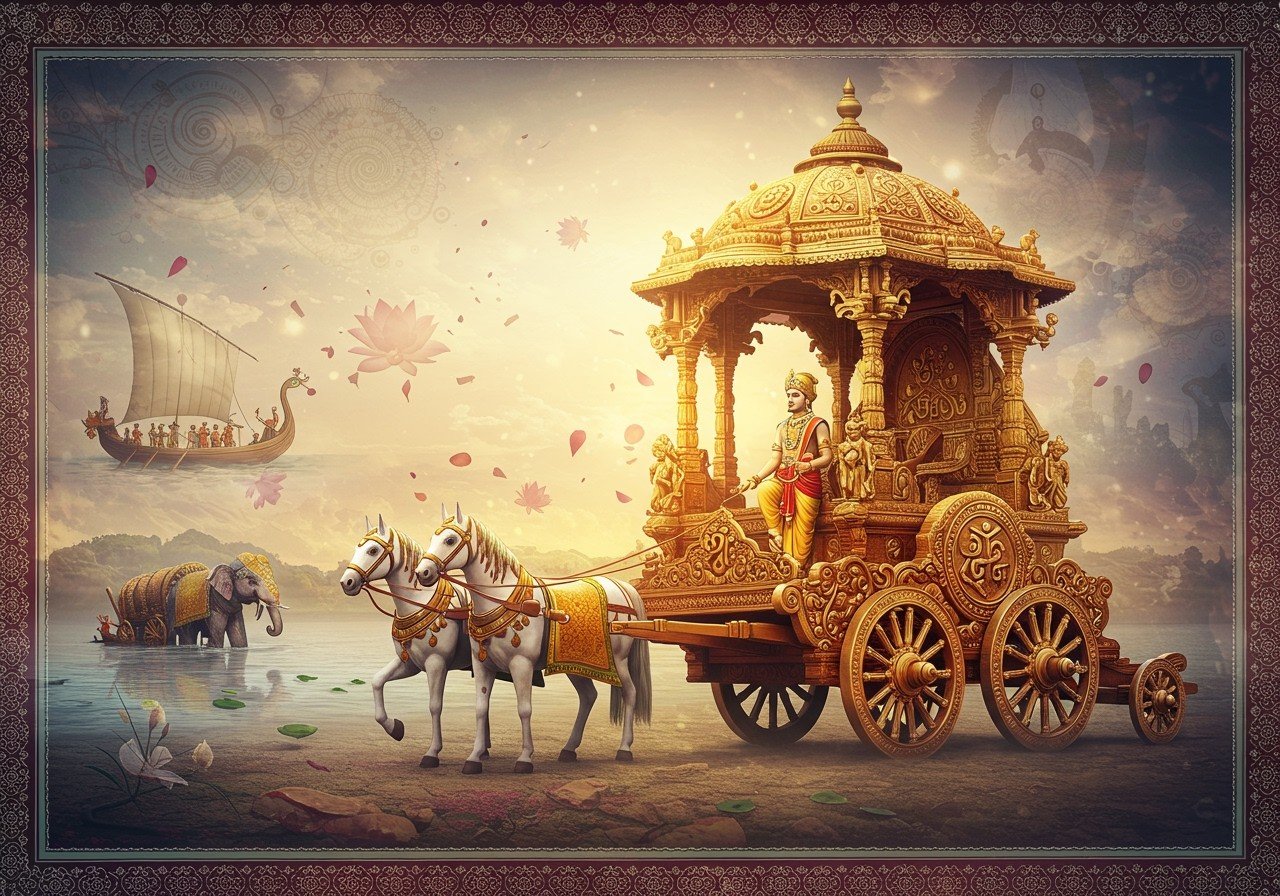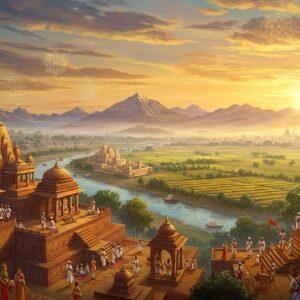
The history of transportation in ancient India offers a fascinating glimpse into a world of innovation and tradition. Transportation wasn’t merely a means of moving from one place to another; it was instrumental in shaping the cultural, economic, and social fabric of the civilization. From the earliest forms of travel to the sophisticated maritime routes, each mode of transportation tells a unique story of ingenuity, adaptation, and the deep connection between people and their environment.
Early Modes of Travel
In the nascent stages of ancient Indian civilization, reliance on animals for transportation was paramount. Elephants, horses, and camels became indispensable partners, carrying people and goods across vast distances. Archaeological discoveries reveal the existence of early wheeled vehicles, including carts and chariots, which revolutionized trade and travel by increasing speed and efficiency. The introduction of the wheel marked a pivotal moment in transportation history.
Rivers, the lifeblood of ancient India, also played a critical role in transportation. India’s extensive network of rivers provided natural highways for trade and communication. Boats and canoes became essential vessels, facilitating the movement of people and commodities. The Indus Valley Civilization demonstrated remarkable advancements in transportation through meticulous urban planning and intricate trade routes. They constructed roads and pathways, creating a robust infrastructure for the movement of goods across different regions.
Roads and Highways: Connecting the Realm
Ancient roads, such as the legendary Grand Trunk Road, stand as testaments to engineering prowess and foresight. These arteries of communication, among the oldest major roads in Asia, facilitated trade, military movements, and cultural exchange. The Mauryan Empire significantly contributed to road infrastructure, implementing milestones and markers to enhance travel efficiency. The establishment of dharmashalas (rest houses) and wells along trade routes provided vital resources and shelter for weary travelers, underscoring the importance of hospitality and community support.
Maritime Advancements: Navigating the Seas
India’s extensive coastline spurred remarkable advancements in maritime transport. Skilled shipbuilders crafted vessels capable of traversing vast oceans, enabling overseas trade with Southeast Asia, the Middle East, and Africa. Bustling ports like Lothal and Muziris emerged as crucial hubs of maritime commerce, facilitating the exchange of goods and ideas. Ancient Indian maritime laws and navigation techniques left an indelible mark on global shipping practices, influencing maritime traditions across the world.
Cultural and Economic Significance
The impact of transportation on ancient India’s culture and economy was profound. Improved travel facilitated the dissemination of religious and cultural beliefs, notably the spread of Buddhism along trade routes. Transportation fueled economic growth, both within India and through trade with other civilizations. Moreover, it influenced social mobility, enabling the exchange of ideas and contributing to the rich tapestry of ancient Indian civilization. The movement of people and ideas helped shape a dynamic and interconnected society.
The Dawn of Rail Transport
The arrival of rail transport in India during the British colonial era marked a transformative chapter in the nation’s history. The first railway line, connecting Bombay (now Mumbai) and Thane in 1853, ushered in an era of faster and more efficient movement of people and goods. This innovation spurred industrial growth and integrated diverse regions and communities, leading to profound socio-cultural changes across the subcontinent.
Diverse Modes of Transport
-
Walking: A primary mode of transport, especially in rural areas and for pilgrims journeying to sacred sites. Walking represented a connection to the land and a personal pilgrimage experience.
-
Bullock Carts: These sturdy vehicles served as workhorses, transporting goods and people over long distances, particularly in rural landscapes. Bullock carts were an integral part of daily life and commerce.
-
Palanquins (Palkis): Luxurious and ornate, palanquins provided a comfortable mode of transport for the wealthy and noble. They were also used to carry deities during religious processions, adding an element of grandeur and reverence. You can find various puja items for religious ceremonies at Poojn.in.
-
Chariots: Driven by horses, chariots symbolized power and prestige, often used by royalty and high-ranking officials. They were not merely a means of conveyance but also a statement of status and authority.
-
Animal Transport: Camels traversed the arid regions, while horses and elephants were common in other areas. Elephants, revered for their strength and stature, played a crucial role in transporting heavy loads and navigating challenging terrains. Explore spiritual products related to animals at Poojn.in.
Additional Insights
-
Early Road Systems: The discovery of well-planned road systems in Mohenjodaro provides evidence of early urban development and the importance of transportation infrastructure. These roads facilitated movement and trade within the civilization.
-
River Travel: River travel was vital for trade and communication, with kings employing ornately decorated boats for their journeys. Rivers served as natural highways, connecting distant regions and cultures. You can find various items used in river-based rituals at Poojn.in.
-
Royal Patronage: Royal patronage often played a role in improving transportation infrastructure, as seen during the Mauryan period under Emperor Ashoka. The establishment of rest houses and the planting of trees along roads demonstrate a commitment to the well-being of travelers. Poojn.in offers products related to ancient Indian figures.
-
Urban Transport: Walking and cycling were prevalent modes of transport in urban areas, reflecting a blend of practicality and environmental consciousness. These methods continue to be relevant in modern times. Explore Poojn.in’s range of traditional products used in various rituals.
Poojn.in: Preserving Ritual Traditions
At Poojn.in, we recognize the sacred significance of transportation in Indian rituals. We offer a curated selection of puja items traditionally used in vehicle-related ceremonies:
- Vaahan Puja Samagri Kit: A comprehensive kit for new vehicle blessings.
- Coconuts for Vehicle Pujas: Fresh coconuts for traditional breaking ceremonies.
- Swastik and Om Stickers: Sacred symbols for vehicle protection.
- Brass Bells: Traditional accessories for trucks and commercial vehicles.
- Kalash Sets: For elaborate vehicle blessing ceremonies.
- Incense and Dhoop: Essential items for daily vehicle protection rituals.
Visit Poojn.in or download our app to discover our complete range of transportation-related puja items. We provide pan-India delivery, ensuring the sanctity of these sacred items during transit. Our dedicated customer service team offers guidance on the proper usage of these items for vehicle-related ceremonies.
Conclusion
The transportation methods of ancient India reflect the resourcefulness and adaptability of its people. From the humble bullock cart to the majestic chariot, each mode of transport carries a rich history, connecting past traditions with the present. As we embrace modern transportation, we acknowledge the enduring legacy of ancient practices, recognizing their continued influence on contemporary Indian society.
FAQs on Ancient India’s Transportation
When did rail transport begin in India? Rail transport commenced in India in 1853, marked by the inaugural train journey between Bombay and Thane.
What is the oldest known form of transport in India? The bullock cart holds the distinction of being the oldest form of transport in India, serving communities for centuries.
How did people travel in ancient India? People in ancient India relied on various modes of transport, including walking, bullock carts, boats, and animal transport.
What role did elephants play in ancient Indian transport? Elephants were indispensable for carrying heavy loads and navigating dense forests, playing a crucial role in logistics and travel. You can find elephant related puja items at Poojn.in.
Did ancient India have established roads? Yes, ancient India boasted significant roads like the Grand Trunk Road, which connected different regions and facilitated trade and communication.
How did waterways contribute to transportation? Rivers and waterways were essential transportation arteries, with boats and ships carrying goods and people, fostering trade and connectivity. Discover products related to water-based rituals at Poojn.in.
Did ancient India have any form of public transport? Chariots and bullock carts functioned as a form of public transport in ancient India, catering to both short and long-distance travel.
What was the impact of transportation on ancient Indian trade? Transportation significantly influenced trade by facilitating the exchange of goods, culture, and ideas across different regions of ancient India.


